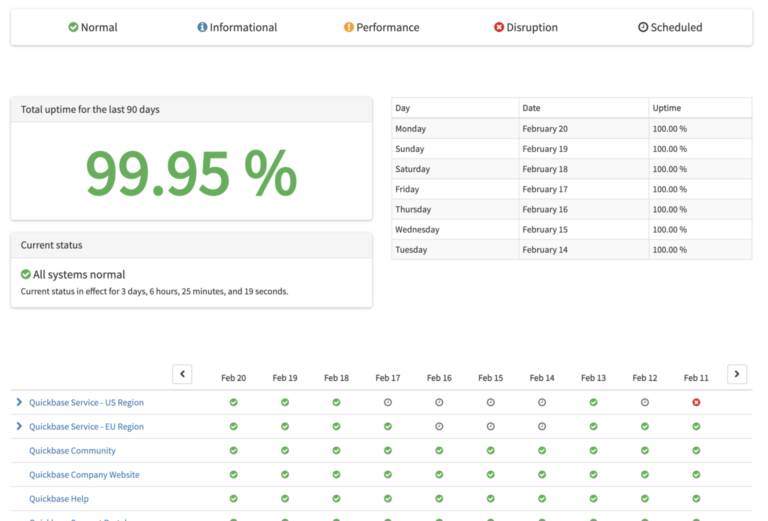A status page is an excellent way to communicate with users during outages. Transparency, historical context, and updates reduce frustrations and build customer trust.
Integrated with your favorite monitoring, alerting, chat, and help desk tools. Showcase your historic reliability with uptime metrics and demonstrate SLAs. Easily keep your audience updated from ‘investigating’ through to resolving.
Resolve Issues Faster
Glitches or outages in your services make it hard to soothe agitated customers over the phone. A status page lets you notify your users about the situation and what’s being done to resolve it. This eliminates one-on-one communication and helps you save time. Showcase your uptime performance and build user trust by publishing performance metrics on your status pages. This will reduce the number of support tickets coming to your team.
You can automate incident management by connecting your status page to monitoring platforms. This will let them create and update incidents on your behalf – freeing up your time to concentrate on resolving them. Also, a well-designed and clear status page will allow you to communicate with your audience in an easy-to-understand way. This can help reduce customer frustration and encourage them to stay loyal to your service. It’s simple, straightforward, and responsive on desktop and mobile devices. The simplicity and clarity of the message build trust with your audience and reduces their anxiety about the outage.
Increase Customer Satisfaction
Users get frustrated when their favorite websites and services go down. This is especially true if they have not been notified about the incident and are left to wonder when the service will be back up. With status pages, however, companies can inform their clients and visitors by sending out messages when the system experiences problems.
This way, customers and users can avoid calling their support team to file a ticket. This helps reduce support costs and increases customer satisfaction.
MRI Software, a real estate and investment management software provider, uses its status page to communicate any issues that might affect its customers. They also use the platform to inform their audience about company news and updates. While some companies shy away from transparency, others embrace it and reap the benefits. Status pages are becoming increasingly powerful and can communicate not just outages but critical metrics, incident reports, maintenance calendars, and more. Integrated with uptime monitoring tools, the best status page platforms offer a complete communication solution for any business.
Reduce Support Tickets
Good examples of status pages are easy to digest from an end-user perspective. If your site is down or going to undergo maintenance, your customers must see the status of the incident in a way they can understand. This helps reduce agitation and worry and prevents users from calling your customer support number in vain.
A status page should also allow your users to subscribe to future announcements so they can be updated when you have more information to share. This saves your support team from having to email everyone who has a question and can help focus their efforts on resolving issues.
You can create a beautiful status page that showcases your uptime and notifies your users of incidents or outages in an easily digestible format. You can customize your status page to include your company logo with an SSL certificate, add unlimited service components, choose your color scheme, brand text, and more. You can even log private incidents and notes for those events you don’t want to broadcast to your user base.
Build Trust
With a status page, you can communicate incidents and maintenance with complete autonomy. You can even use it to show your historical uptime, reducing the number of questions you receive from customers about your performance and reliability. Your status pages must be clear and straightforward. The best way to do this is by only showing relevant services to your users. This means you can focus on the problems your customers care about most rather than having to explain the status of unused services.
If you have multiple services, you must give your users the option to subscribe to updates for each service. This will help them avoid alert fatigue and ensure they only receive notifications of issues they’re interested in. You can also provide more details about an incident when it has been resolved. This will help your customers feel valued and reassure them that you take their feedback seriously. They’ll have more faith in your abilities to deal with challenges in the future as a result of this. Include a postmortem, a thorough analysis of the occurrence, and the steps to ensure it doesn’t happen again.
Reduce Costs
Keeping users informed of system issues reduces the number of support tickets. This saves the time IT teams spend on answering questions and frees up resources to focus on resolving outages. It also deflects user frustrations that arise when they’re kept in the dark during an outage.
Status pages provide clear and straightforward communication to end-users during an incident. Users no longer need to call or email numerous departments for the same updates because the information is centralized in one location. Using a status page solution, you may tailor how your incidents are conveyed and increase client trust. You can use private notes to work on the incident with your team.
It also helps you highlight your reliability with historical uptime charts that are automatically updated and accessible to your users. This way, you can prove your uptime commitment to your users and build their trust. This can increase customer retention and attract new customers who value transparency and dependability. Moreover, you can improve your SLA by keeping your users happy during outages.


